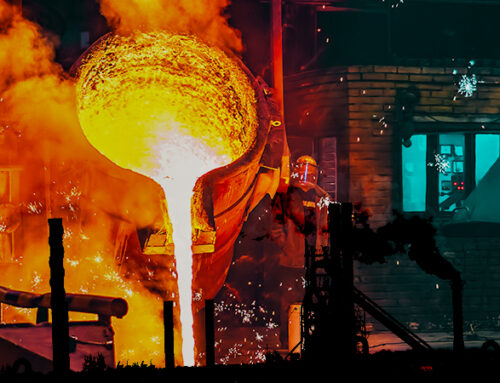In recent months questions have been asked around the future of Britain’s gas infrastructure and pressure put on both the Government and Ofgem to address the question of gas network decommissioning.
The UK Government has entered into a legal commitment to reduce the country’s net carbon dioxide emissions to zero by 2050. There are several pathways that have been identified to achieve this goal – one alternative is to pursue widespread electrification with electricity supplied from renewable and other low carbon sources such as nuclear. Another alternative involves the use of hydrogen to displace methane, including potentially for home heating.
These alternatives require significantly different infrastructure. In the case of the former – a massive increase in electricity transmission and distribution networks will be needed, while existing gas networks would become largely redundant. The second alternative would potentially have a lower requirement for new electricity infrastructure and would enable the ongoing use of existing gas networks.
While no policy decisions have been taken to date on any role for hydrogen in decarbonisation, it is looking less likely to be the preferred approach to the decarbonisation of heating, a major source of gas demand, particularly for distribution networks. While the Government has a plan to phase out the use of gas boilers from 2035, this timetable may slip, and various forecasts suggest the use of methane will continue well into the 2040s and even past 2050, meaning gas will still be in use for another two to three decades or more. The Government has no plans in respect of what will happen to gas infrastructure if and when the use of gas is phased out. And since there is no gas network decommissioning plan, there is no funding, and no decision on how the costs will be covered and by whom.
“If decarbonisation of heating by 2050 is successful, there is a high likelihood of stranded UK gas network assets. There will also be some costs associated with the physical disconnection of buildings and decommissioning of the gas grid. Ultimately, consumers bear the responsibility for and risks of these issues,”
– Richard Lowes, Senior Associate, Regulatory Assistance Project
Ofgem is considering whether it should take the lead and begin to apply some of these costs in the next price control period, however it is reluctant to act prematurely in respect of a specific consumer decommissioning charge. But it does recognise that gas assets may have shorter lives as a result of decarbonisation and is considering adjusting depreciation rates to take account of this. This would reduce the regulated asset value, and may require network operators to repay debt and cancel associated swaps to maintain debt covenants such as gearing ratios. These early repayments and cancellations may incur financial penalties, creating additional costs that must be recovered from consumers.
Reducing the asset base will make it harder for network operators to raise capital and enter into interest rate, currency and inflation derivatives. It may impact their refinancing programmes, and, given the long-dated nature of regulated utility debt (10-15 years or longer), this could become a problem almost immediately as network companies attempt to issue debt maturing after 2035. They may find it is not possible to do so, particularly in the absence of a wider decommissioning plan which would limit them to shorter tenors and risk unusually large debt maturities, with the associated refinancing risk, in the mid-2030s.
“While Ofgem is not responsible for energy policy, it does now have duties in respect of net zero delivery. This places the regulator in a difficult position – it needs to structure market rules which encourage decarbonisation but it must also ensure that consumers are not exposed to undue costs, including those which may arise as a result of a lack (or perceived lack) of resilience. If Ofgem fails to act in relation to gas network decommissioning it risks breaching its net zero duties, but if it acts inappropriately or prematurely, it risks destabilising the entire financial model for gas network operators,”
– Kathryn Porter, Consultant, Watt-Logic
Ofgem needs to be very cautious about any changes to the price control methodology. Making such changes in respect of gas network decommissioning while there is still so much uncertainty over the timing of such decommissioning, and in the absence of a wider plan including a funding plan, risks undermining the financial resilience of network companies, raising the cost of debt, limiting the ability of gas network operators to manage financial risks, and restricting their access to capital. That would increase costs to consumers (since the costs of capital are included in network charges) and would create a risk that network companies are unable to finance ongoing network operations prior to any decommissioning.
In this new report, I examine the various forecasts of gas use over the coming decades whether methane or hydrogen, and consider the impact Ofgem’s proposed accelerated asset depreciation could have on the finances of the gas network operators.
ABSTRACT
The Government and Ofgem are under pressure to address the question of gas grid decommissioning on the assumption that net zero plans will make gas infrastructure redundant. But questions over the realistic timing of decarbonisation and the possible use of hydrogen mean gas networks could continue to be used for decades to come. Premature or poorly defined actions on decommissioning such as accelerated asset depreciation risk the financial stability of gas network operators and threaten their ability to carry out essential ongoing investment.







Ultimately, consumers bear the responsibility for and risks of these issues,
Herein lies the problem. We never got the chance to vote for this and if we had we wouldn’t be where we are now.
I suspect that many of these targets will slip or be softened as consumer pain ramps up, which is why it’s important not to pre-empt reduction in gas infrastructure use by eroding the financial model too soon.
Crikey we don’t need to be wasting anymore money on Net Zero gas is going to be main source of domestic heating for decades. Far better to spend the money on making sure everyone has an efficient boiler and properly insulated house.
I agree, and say in the report that since methane use is likely to continue for decades we should not act prematurely on decommissioning gas infrastructure.
I don’t think either of the two main political parties are up to the job of getting to Net Zero, they simply don’t have a clue about how to go about it without endangering our energy security; endangering our national security; inflicting poverty on the middle classes and fatally damaging our economy.
I disagree with your statement:
“The second alternative would potentially have a lower requirement for new electricity infrastructure…”
If the hydrogen gas delivered were to be green hydrogen i.e. electrolysed using renewable or low carbon electricity, then this option would require a roughly six-fold INCREASE in electricity infrastructure compared to an option in which the renewable or low carbon electricity was used to (primarily) operate heat pumps.
The upgrade of the electrical grid infrastructure would be larger in a non-hydrogen scenario.
This increase arises because, starting with one unit of renewable or low carbon electricity, after electrolysis, pressurisation and burning within the home, only about 0.5 units of heat are delivered. In contrast, if that one unit of renewable electricity were used to operate a heat pump with SCOP of 3, then 3 units of heat would be delivered.
In either case, the sums involved make reduction of heating demand by improved insulation of homes look like a very sensible move.
Best wishes: Michael
Apart from stupidly entering a legal agreement, I still fail to see what affects reducing our miniscule emissions, compared to the big emitters, can have on the World’s climate.
I would like to see us eventually pull away from dependence on fossil fuels, but we should have started a big move towards nuclear two decades ago ( using proven designs )
Regarding green energy, can anyone tell me accurately what the daily weather forecast is going to be for say three decades into the future?
Reliance on windmills has left us very vulnerable, as have interconnectors.
Wealth, aka economic growth, depends on cheap reliable energy.
Have the Conservatives, and soon to be in power, Labour party, managed to work this out?
I agree, but unfortunately too many people, including in the energy industry itself, are still hung up on the false “renewables are cheap” narrative, so they think lots of renewables are a good thing, when the reality (in the UK context) will be expensive and unreliable energy.
Oh well, I suspect we will have blackouts, contraction of our economy and be unable to fund health and social care properly, along with the Police, and crucially our armed forces.
The use of hydrogen in homes is inefficient and not without increased risks and costs. I do however see hydrogen having a use in electricity generation at an industrial scale as a means of levelling otherwise intermittent zero carbon generation.
I’m lucky, I have a 35 Yr old GEC Nightstor 100 and a 3phase supply. This is the future. Costs of improving the capacity of the electricity network will be born by the customer but can easily be predicted and done in a planned way as the gas network is decommissioned.
Ed Hogbin : “I do however see hydrogen having a use in electricity generation at an industrial scale as a means of levelling otherwise intermittent zero carbon generation.”
For the amount of wind/solar electricity expected to be needed by 2050, 570 TWhrs/year, the final cost of reliable, secure, dispatchable electricity supplied to the grid is roughly the double of the initial cost of the wind/solar electricity. See The Royal Society’s “Large-Scale Electricity Storage” Report : Chapter 8 Figure 24 on P24 or Chapter 3 Figure 14 on P32.
Now we know that at the next Renewables Auction Round 6 (AR6) taking place later this year the price of fixed offshore wind at 2023 prices will be £100.27/Mwhr and for floating offshore wind, £241.75/MWhr.
So this means that according to the RS report the final cost of secure, dispatchable electricity supplied to the grid using wind/solar/hydrogen will be around £200/MWhr at 2023 prices.
This should be compared to the price of £50 to £70/MWhr (2021 prices) that Alastair Evans, Director of Government and Corporate Affairs, RR SMR, quoted to the HoC Energy Security & Net Zero Committee 15/11/2023 in answer to questions Q133 and Q134 for reliable, not chaotically intermittent, nuclear power and that the EDF EPR built in Finland, using the same technology as Hinkley Point C, is supplying the Finnish grid at £53/MWhr.
Great article. Couldn’t agree more.
The use of the methane gas network for hydrogen is an obvious transition, but only when the efficiency of hydrogen generation is economic, and it is used in CHP to avoid the 40-50% losses that occurs in electrical power generation as a separate process in the power industry.
The worry isn’t hydrogen, even with the stricter handling and safety requirements than methane, but the current interest and drive to Ammonia in some industries.
If you want a real environmental disaster, then Ammonia outranks all other potential fuels.
a) Toxic
b) Lower energy density
c) corrosive
d) The oxidation product NO2 is 270 times more powerful as a Greenhouse gas than CO2
e) Nitrous oxide absorption leads to vitamin B12 deficiency with all the resultant nerve damage……..just ask anyone whose been sniffing NO2 and ended up in hospital, disabled for the rest of their shortened life.
yes methane is bad, but NO2 is 10x worse than methane.
With any transition, it is the rate of transition that is important and to follow the necessities of economic stability.
Politicians can and do waste billions every year and often don’t look at the best way to achieve their goals because of prejudice. Taking Rwanda for example, spending hundreds of millions on exporting possibly a few hundred illegal immigrants, when they could turn the driving license into an identity card, where everyone has to have one.
Many illegal immigrants like the lack of ID cards in this country where they can disappear into the black economy.
They don’t understand how some complex issues can be simplified because of their own prejudice against identity cards, and yet for certain ages 40 – 69 about 85% of people have them. I use my driving license when I need to prove my identity for legal work, bank accounts etc.
There are always ways to deal with complex issues, economically and practically, but we only have to hope that the politicians have more ability than the likes of politicians like Boris Johnson who reportedly had no technical ability and who was apparently easily swayed by the last person he got advice from.
A microturbine CHP system could easily replace any simple gas boiler, and whilst they may currently cost £15,000 when there is very little demand, could easily be engineered and produced for about £2,000 – £3,000, i.e. mass production, about the same price as a gas boiler now, much cheaper than a current heat pump system, with all the great complexity of changing the whole house plumbing and heating system.
The gas network should still be needed many decades from now, it should just be transporting a ratio of methane:hydrogen over the next few decades that should be steadily switching to hydrogen over time.
Some houses may find heat-pumps more economic, but microturbine CHP using hydrogen fuel has advantages for certain applications.
I wouldn’t worry too much, as the economics of various processes and manufacturing costs change, new products and systems will replace the old, and will be much more efficient.
One can imagine having buildings with CHP exporting electricity in winter when they have excess and that excess being used in other buildings with heat pumps.
There doesn’t need to be any waste, or decommissioning of the gas network.
How would you deal with the intermittency issue?
I cannot see hydrogen replacing methane as it has one third the energy density by volume therefore necessitating a 3-fold increase in volume flow requiring much bigger pumps and higher pressures. The hydrogen corrodes the steel pipes used for bulk methane transport and its tiny molecular size means it leaks like crazy and there is obviously no odourant available for detection.
Since heat pumps and the massive national and local grid upgrades necessary are clearly not feasible then I would suggest we produce green methane. Green methane, which already exists from anaerobic digestion, can be made from hydrogen via the Sabatier process. Of course this involves a further loss of energy but it does mean we can use all the existing infrastructure and appliances. In addition, ice vehicles can be easily converted to methane and in fact methane or CNG vehicles already exist in the UK and all over the world and would provide a better solution to transport than bevs.
Hopefully we can stop the enormous economic damage that would be done by ripping out our gas network, as has already been done by explosively demolishing our coal-fired power stations, until the CAGW/Net Zero scam is exposed.
I can’t either, but the point is that its’ currently undecided from a policy perspective so for Ofgem to start planning for decommisssioning gas grids when hydorgen is still on the cards is pretty premature.
I note in my report that we’ve been taking an absolutist approach to net zero which is likely to fail is 2050 is the target. What would make more sense would be to take a more incremental approach – encourage hybrid heating systems which use gas boilers to boost cold weather performance. You would save significant amounts of emissions and be much more cost effective than trying to leap straight to a fully electrified outcome.
Kathryn : From the conclusion of your report : “The transport sector is largely irrelevant as far as methane is concerned although there may be some applications in respect of hydrogen.”
Although I don’t believe that we have CAGW requiring the unilateral implementation of Net Zero by 2050, I would agree with you that an incremental approach makes far more sense if we are to attempt to achieve net zero emissions of anthropogenic CO2. An incremental approach to transport would be to use green methane/CNG instead of bevs which are impractical, expensive and dangerous. Existing ices can be converted to CNG relatively easily. This means that the CO2 emissions caused by the scrapping of existing cars and building new bevs is eliminated whilst the CO2 and Nox emissions will drop enormously relative to petrol and diesel fuels. This also reduces the amount of expensive electricity generation required from renewables and the costs of expanding the national and local grids for all the bev chargers that will be required.
There is green methane and green LPG (bio-propane), and bio-diesel.
With all the oils produced worldwide for making cakes/biscuits/crisps/frying, all of which are unhealthy, we would be better of health wise using the oils for producing fuels for bio-diesel and bio-propane (green LPG).
I’m sticking with LPG as a car fuel and as and when LPG production goes to just bio-propane, instead of propane from fossil oil/gas sources, I don’t have to buy a battery car to be “green” if I’m in the loop for the CO2 atmospheric cycle.
We just need to optimise the oils/fats recovered from the sewage system to help increase the bio-diesel and bio-propane output, and not just rely on green methane.
The sewage companies burn the solids, and you wonder if there are any extractable oils left after the anaerobic digestion process used to produce methane.
Of course, you wonder if they should use the sewage as a feed source for algal growth, linked to photosynthesis to capture CO2, and to produce oils, in huge ponds………Now that could give significant oil production. We get massive algal blooms in the sea in summer from the warm ocean/sea with all the sewage being pumped out there……….why not put it to good use?
Another thoughtful and comprehensive report Kathryn.
I was struck by the NIC map with the industrial hubs and the connections for hydrogen and CO2.
A quick review will highlight how the big single gas using plants have reduced.
For CCS we are rapidly getting to only having power stations (increasingly lower utilisation rates) and highly dispersed small users – buildings and homes.
The demand profile is changing way more quickly than the plans!
Regards
Andrew
It doesn’t have to go to 100% hydrogen. It could remain as a mixture of methane and hydrogen and any other bio-produced gas, methane, ethane, propane, butane.
If the burners of appliances/industrial equipment are developed to cope with a mixture that can be produced at a specific consistent ratio, there doesn’t have to be an obsession with the poorer economics of hydrogen, although for the production of ammonia for fertilizer production, if you get away from fossil based hydrogen production the cost of green hydrogen will be critical for agriculture and inflation etc.
Will we need to go back to crop rotation as a means to reduce the huge quantities of fertilizer used in agriculture to avoid the higher costs of green hydrogen if the economics cannot be improved sufficiently?
As it only requires hot water (70*C to 95*C) to heat offices and homes, I am surprised that more attention is not given to it. Electricity would then only be required for computers, TV, lighting, etc.
Could part of the gas infrastructure be used to distribute hot water? Hot water in supply tanks could be heated by intermittent marginal cost renewables via immersion heaters. This would increase the utilisation of wind turbines, outside peak demand hours, and reduce the the average cost of their generated energy.
As it only requires hot water (70*C to 95*C) to heat offices and homes, I am surprised that more attention is not given to it. Electricity would then only be required for computers, TV, lighting, etc.
Could part of the gas infrastructure be used to distribute hot water? Hot water in supply tanks could be heated by intermittent marginal cost renewables via immersion heaters. This would increase the utilisation of wind turbines, outside peak demand hours, and reduce the the average cost of their generated energy.
On another subject, may I take issue with Tom Stone on the subject of ammonia. This compound has been stored and transported in liquid form successfully for over 100 year at atmospheric temperature. Any leakage is quickly detected; and minor inhaling of the gas can be washed out of the system as it is highly soluble in water. Its heat of combustion is about half that of gasoline. Its big problem is the CO2 given off in its large scale production. Green ammonia is now being produced on small scale units using electricity. Hydrogen, on the other hand, presents many problems, cryogenic storage, leakages not easily detectable, metal cracking, etc.